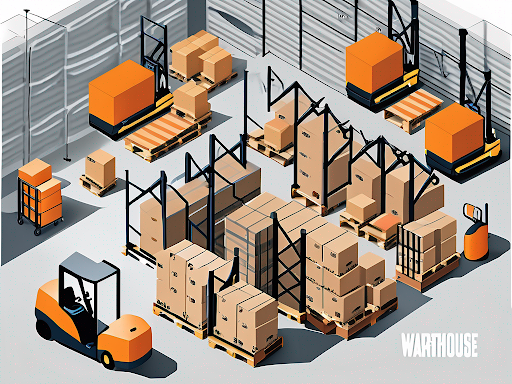“A well-organized warehouse is like a symphony—a harmonious blend of processes that work together to create efficiency and satisfaction.”
When it comes to logistics and supply chain management, the role of a warehouse service provider cannot be overstated. These providers are critical in ensuring that goods are stored, managed, and shipped efficiently.
- Factors to consider when choosing a warehouse service provider
- The role of these services
- The crucial role of location of a warehouse provider
Table of Contents
ToggleKey Factors in Selecting a Warehouse Service Provider
Choosing the right warehouse service provider requires a careful assessment of several factors. Assessing Your Business Needs
Before selecting a warehouse provider, it’s crucial to assess your specific needs. Key considerations include:
- Volume of Goods: How much storage space will you need? This will help you determine the size of the warehouse you need.
- Product Type: Do your products require special handling, like climate control, or are they more durable?
- Shipping Frequency: How often do you need shipments processed?
To streamline your search, create a detailed list of your requirements and constraints. This will help in effectively communicating with providers and narrowing your options.
Additionally, consider seasonal fluctuations in inventory levels. If your business experiences peak seasons, choose a provider that can adapt without excessive costs. This foresight will also aid in negotiating favorable terms.
Evaluating the Provider’s Capabilities
Once you’ve assessed your needs, the next step is to evaluate what the warehouse provider has to offer. Look for capabilities beyond simple storage:
- Inventory management systems
- Pick and pack fulfillment services
- Kitting and fulfillment services
- Order fulfillment and shipping processes
- Scalability options for your growing business
Moreover, examine their technology solutions. Advanced warehouse management systems can significantly improve efficiency and reduce errors.
Providers should be willing to showcase their technology—if they can’t, it might be a red flag.
Additionally, consider the integration capabilities of their systems with your existing platforms. Seamless integration can streamline operations, making it easier to manage inventory and fulfill orders in real time, which is crucial for maintaining customer satisfaction.
Checking the Provider’s Reputation
A provider’s reputation can tell you a lot about their reliability and service quality. It’s always wise to conduct thorough research:
- Read customer reviews and testimonials.
- Request references from past or current clients.
- Check online platforms for feedback, such as Google and industry-specific forums.
Moreover, inquire about their safety records and any compliance certifications. A provider with a strong reputation is often more trustworthy, reflecting their commitment to service excellence.
Flexibility and Location of the Warehouse Provider
Another critical consideration is the flexibility and location of the warehouse provider. The provider should be able to accommodate changes in your business, such as scaling up or down based on seasonal demand, and adapt to any logistical challenges that arise.
- Proximity to Markets: Ensure the warehouse is strategically located near your target markets to reduce shipping times and costs.
- Adaptability: The ability to scale services, adjust storage capacities, or handle unexpected increases in demand is crucial for long-term partnerships.
The Role of Warehouse Services in Business
Warehouse services act as a critical backbone for businesses that need to store and distribute their products. They help in managing inventory levels, optimizing supply chains, and ensuring that goods reach customers in a timely manner.
By outsourcing these services, companies can focus on their core functions, such as product development and marketing.
This strategic approach allows businesses to leverage the expertise of warehouse professionals, who are equipped with the latest technology and best practices in inventory management.
Moreover, effective warehouse management can enhance customer satisfaction by reducing lead times and ensuring order accuracy.
In today’s competitive market, a strong warehousing strategy can be a decisive advantage. The integration of advanced technologies, such as automated picking systems and real-time inventory tracking, has revolutionized warehouse operations, enabling businesses to respond swiftly to market demands and customer preferences.
Different Types of Warehouse Services
Understanding the various types of warehouse services can help businesses determine which options best meet their needs. Typically, warehouse services include:
- Public Warehousing: Ideal for short-term and seasonal storage, where businesses pay for the space they use. This flexibility allows companies to scale their storage needs according to fluctuating demand.
- Private Warehousing: Owned by companies for exclusive use, offering greater control over operations. This option is particularly beneficial for businesses with consistent inventory needs, as it allows for tailored processes and direct oversight.
- Contract Warehousing: Long-term agreements where services, including labor and equipment, are provided. This arrangement can lead to cost savings and improved efficiency, as the warehouse operator becomes familiar with the specific requirements of the business.
- Distribution Centers: Focus on efficient order fulfillment and rapid distribution of goods. These centers are strategically located to minimize transportation costs and ensure quick delivery to customers.
Each of these services serves different logistical needs, and understanding them can facilitate better decision-making in the selection process.
The Importance of Location in Warehouse Services
Location is not just a strategic choice; it’s often the linchpin of effective warehousing. The location of your warehouse can determine the efficiency of your operations, making it a non-negotiable factor in provider selection.
Proximity to Customers and Suppliers
When selecting a warehouse, proximity to key stakeholders—such as customers and suppliers—is crucial. A strategically located warehouse offers several benefits:
- Reduced Transportation Costs: A warehouse near your customers can lower shipping expenses.
- Faster Delivery Times: Shorter distances lead to quicker deliveries, enhancing customer satisfaction and building loyalty.
Additionally, having a warehouse close to suppliers promotes:
- Better Collaboration: Easier communication and faster inventory restocking.
- Responsive Management: Improved inventory turnover and quicker response to demand changes.
Accessibility and Transportation Links
Besides proximity, ease of access to major transportation hubs such as highways, railways, and ports is crucial. A warehouse with strong transportation links can facilitate smoother operations:
- Quicker restocking from suppliers
- Faster delivery to customers
- Reduced risk of transit delays
A thorough evaluation of the location can save you time, money, and a fair amount of stress.
Additionally, the surrounding infrastructure plays a significant role in operational efficiency.
Understanding these factors can lead to a more informed choice that aligns with both current needs and future growth plans.
Technology and Innovation in Warehouse Services
The warehouse sector is rapidly evolving, thanks in no small part to technological advancements. This is an era where innovation can lead to significant efficiency gains and cost reductions.
The Role of Technology in Warehouse Management
Modern Warehouse Management Systems (WMS) streamline operations with:
- Real-time tracking for inventory and order processing
- RFID & barcode scanning to reduce errors and improve accuracy
- AI-driven predictive analytics for demand forecasting and stock optimization
These tools enhance efficiency, minimize waste, and improve customer satisfaction by ensuring timely deliveries.
Strategic Planning and Optimization Tools
Before implementing warehouse operations, businesses need robust planning tools to make informed decisions about their space and resource requirements. Leading warehousing operations rely on:
- Warehouse space calculators
- Inventory forecasting software
- Layout optimization tools
- Capacity planning systems
These digital tools help businesses make data-driven decisions about their warehousing.
Cost Implications of Warehouse Services
Cost is always a significant factor when evaluating potential warehouse service providers. However, understanding the full scope of pricing structures and potential hidden costs is essential.
Understanding Pricing Structures
Warehouse fees can vary widely based on a number of factors, including:
- Type of storage unit required (bulk, shelving, specialized)
- The level of service provided (basic storage vs. comprehensive management)
- Contract length and agreement terms
Having a clear understanding of these elements will help you avoid any unexpected expenditures down the line. Make sure that your provider is transparent about pricing and explains all fees involved.
Hidden Costs to Watch Out For
Even the most straightforward pricing structures can have hidden costs. Here are a few examples to watch for:
- Additional fees for overtime labor
- Costs related to inventory handling and management
- Unexpected charges for damaged or missing goods
- Increases in rates during peak seasons
To avoid financial surprises, carefully review your contract and ask key questions upfront. Consider:
- Inventory Discrepancies: Clarify how lost or damaged items are handled, and if replacement costs or insurance apply.
- Returns and Restocking Fees: Be aware of any fees tied to frequent returns.
Additionally, factor in the impact of technology on warehousing costs. While advanced inventory systems can improve efficiency, they may come with added fees or require staff training.
Understanding both visible and hidden costs will help you make an informed choice.
Making the Right Warehouse Choice for Your Business
In conclusion, selecting the right warehouse service provider is a critical decision that can greatly impact your business operations, efficiency, and customer satisfaction.
By thoroughly assessing your business needs, evaluating provider capabilities, and considering factors such as location, reputation, and technology integration, you can make an informed choice.
Additionally, being aware of pricing structures and potential hidden costs will ensure that your partnership with a warehouse provider is both cost-effective and scalable as your business grows.






